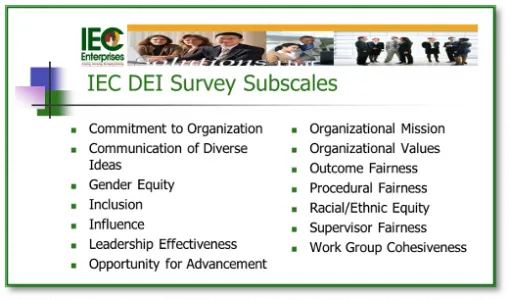
Diversity, Equity, Inclusion. Although it has long been recognized as an issue, the events of this year have catapulted it to the top of the list for many organizations. The 2020 PwC Global Diversity & Inclusion Survey had an all-time high of 76% of respondents indicate that DEI “…is a priority or value” of their organization. Let's discuss moving from priority to a data-driven strategy.
From Priority to Strategy
Even in organizations that have embraced DEI they often struggle with implementing effective DEI strategies. In the same PwC survey, one-third of the respondents still see DEI as a barrier to individual and organizational success.
I have devoted the last 30 years of my consulting career to helping public and private sector organizations implement transformational DEI programs. I’ve seen organizations succeed greatly and others fail spectacularly. The difference often came down to the ability of the DEI program to provide decision-makers comprehensive, trusted and current data. It is data (not training) that lays the foundation for DEI success. Strategy not informed by data is guesswork. The most common source for the data is the employee survey. However, all surveys are not equal.
How Do DEI Surveys Help Organizations?
The employee survey is a process that takes the "temperature" or "pulse" of the organization. Surveys are used to develop an understanding of employee attitudes and perceptions about the organization. Also, they are useful tools to gauge employee reactions to recent changes in the organization or its business.
Don’t Monkey Around With Your Data
Some of the most spectacular failures we have witnessed have been when organizations attempted to develop and launch their own DEI survey using one of the free or inexpensive survey tools. They see this approach as a way to save money while still generating the data they need. However, they fail to realize that creating surveys, especially DEI surveys, is far from simple. It’s actually rooted in science, with a whole field of PhD’s researching and studying how to create questions and surveys that provide accurate, reliable and non-misleading answers.
Having general survey experience is just not a strong enough foundation for DEI survey development, for several reasons.
- You need an in-depth understanding of DEI issues. Because DEI is so encompassing, researchers have worked hard to identify categories of issues to explore to best assess DEI in organizations. When organizations “guess” about what they think should be on their survey, they often miss issues that are having a greater impact on employee satisfaction than those included on their survey.
- How you ask the questions is just as important as what you ask. A multiple choice question that asks, “Are you getting clear information from your manager and is it helpful?”, may sound like a good question. However, how do you respond to the question if the information you get from your manager is clear but not helpful? You won’t know your employees were confused by the question until after the data is collected and, then, it’s too late.
- Your survey may not provide the real data you need. Getting an overall view of your organization is a start. However, if you cannot analyze the data by demographic groups (race, gender, generation, job function, location, etc.), conclusions drawn from the data about the level of employee satisfaction may, at best, be misleading; and, in the worst case, may fail to identify dissatisfaction within the very demographic groups you are most concerned about. For example, if 80% of your leaders are male and 80% of your employees are male, you may have a very high positive response to the question, “Are you satisfied with the representation of your group in management?”. If you are not able to break this data down by gender you may miss the fact that women may not be nearly as satisfied as men. Being able to break down data by any and all demograhpics and groups is imperative.
- Developing your own survey can delay DEI action. The average organization will take 6-12 months to: research, design, develop and launch their in-house-developed survey; collect and analyze the resulting data; and report the findings. While you are waiting on the data, critical actions by the DEI program will be on hold. This is precious time lost and may result in your losing the momentum and commitment you worked hard to build.
This has been part of my life’s work. And I want to see more successes and less failures in DEI initiatives. That is why I worked with Mindset to bring IEC’s DEI model to a global audience.
IEC’s Survey on Mindset
At IEC and Mindset, we take data seriously. IEC’s DEI survey was designed to provide the comprehensive data needed to lay a strong foundation for DEI efforts. It has been used to launch the DEI programs of scores of Fortune 500 companies, government agencies, universities and not-for-profit organizations. Best of all, you can have the data you need to launch your DEI effort in weeks … not months.
To create the survey, IEC identified DEI success factors from research and created questions and subscales (constructs) to assess those factors and refined the model over time. The result is a comprehensive survey that is efficient, cost effective and above all, accurate. This normed, referenced and reliability tested instrument solicits a broad spectrum of information from employees and managers across 14 subscales.

With IEC’s DEI Survey on Mindset, you have the ability to isolate and analyze the data for any combination of demographics. The results is a DEI survey process that gives you visibility into how people experience work, and what they experience within any group, especially under-represented groups. It exceeds the expectations of clients.
With IEC’s partnership with Mindset, you can quickly, accurately and completely collect the data needed to provide direction for your DEI effort. DEI leaders can focus on their strengths (i.e. providing strategic leadership) knowing they have the data they need to make informed decisions.
Regardless of how you acquire DEI data, please make sure you can drill down into the data for all groups. It’s important. And we are always here to help.
